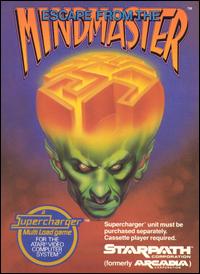| Escape From the Mindmaster | |
|---|---|
 Cover art | |
| Developer | Starpath |
| Publisher | Starpath |
| Designer | Dennis Caswell |
| Platform | Atari 2600 |
| Release | |
| Genres | First-person maze adventure |
| Mode | Single-player |
Escape from the MindMaster was a video game for the Starpath Supercharger addon for the Atari 2600 published in 1982 by Starpath.
Contents
Escape from the MindMaster utilizes a tape cassette through the Starpath Supercharger. This is used to bypass the 2K limitation of available memory in the Atari 2600. Each game has 6 levels, 2 levels per load, giving an effective total of 6K for each game, which allows for better graphics and more complicated gameplay than the average 2K cartridge. A prototype version of the game was created, but these plans were shelved after Starpath merged with Epyx in 1984. [2] A prototype for the ColecoVision was also produced. [3] [4]